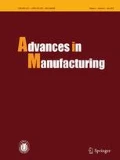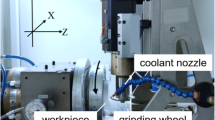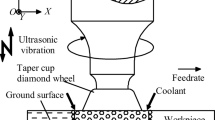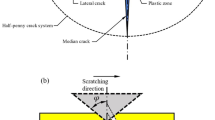Abstract
Mechanisms for removal of materials during the grinding process of monocrystalline silicon have been extensively studied in the past several decades. However, debates over whether the cutting speed significantly affects the surface integrity are ongoing. To address this debate, this study comprehensively investigates the effects of cutting speed on surface roughness, subsurface damage, residual stress, and grinding force for a constant grain depth-of-cut. The results illustrate that the changes in the surface roughness and subsurface damage relative to the grinding speed are less obvious when the material is removed in ductile-mode as opposed to in the brittle-ductile mixed mode. A notable finding is that there is no positive correlation between grinding force and surface integrity. The results of this study could be useful for further investigations on fundamental and technical analysis of the precision grinding of brittle materials.







Similar content being viewed by others
References
Miguélez MH, Soldani X, Molinari A (2013) Analysis of adiabatic shear banding in orthogonal cutting of Ti alloy. Int J Mech Sci 75:212–222
Sun J, Wu YH, Zhou P et al (2017) Simulation and experimental research on Si3N4 ceramic grinding based on different diamond grains. Adv Mech Eng 9(6):1–12
Wu CJ, Li BZ, Liu Y et al (2017) Surface roughness modeling for grinding of silicon carbide ceramics considering co-existence of brittleness and ductility. Int J Mech Sci 133:167–177
Schnurbusch G, Brinksmeier E, Riemer O (2017) Influence of cutting speed on subsurface damage morphology and distribution in ground fused silica. Inventions 2(3):15. https://doi.org/10.3390/inventions2030015
Chen X, Xu J, Fang H et al (2017) Influence of cutting parameters on the ductile-brittle transition of single-crystal calcium fluoride during ultra-precision cutting. Int J Adv Manuf Technol 89:219–225
Ma L, Li C, Chen J et al (2017) Prediction model and simulation of cutting force in turning hard-brittle materials. Int J Adv Manuf Technol 91:165–174
Huang H, Yin L, Zhou LB (2003) High speed grinding of silicon nitride with resin bond diamond wheels. J Mater Process Technol 141:329–336
Wu C, Pang J, Li B (2019) High-speed grinding of HIP-SiC ceramics on transformation of microscopic features. Int J Adv Manuf Technol 102:1913–1921
Li J, Fang Q, Zhang LC et al (2015) Subsurface damage mechanism of high-speed grinding process in single crystal silicon revealed by atomistic simulations. Appl Surf Sci 24:464–474
Li J, Fang Q, Liu Y et al (2014) A molecular dynamics investigation into the mechanisms of subsurface damage and material removal of monocrystalline copper subjected to nanoscale high speed grinding. Appl Surf Sci 303:331–343
Goel S, Faisal NH, Luo XC et al (2014) Nanoindentation of polysilicon and single crystal silicon: molecular dynamics simulation and experimental validation. J Phys D Appl Phys 47:275304
Choi DH, Lee JR, Kang NR et al (2017) Study on ductile mode machining of single-crystal silicon by mechanical machining. Int J Mach Tools Manuf 113:1–9
Yang X, Qiu ZJ, Lu C et al (2017) Modeling the strain rate sensitivity on the subsurface damages of scratched glass ceramics. Ceram Int 43:12930–12938
Young HT, Liao HT, Huang HY (2007) Novel method to investigate the critical depth of cut of ground silicon wafer. J Mater Process Technol 182:157–162
Liu HJ, Dong ZG, Kang RK et al (2015) Analysis of factors affecting gravity-induced deflection for large and thin wafers in flatness measurement using three-point method. Metrol Meas Syst 22:531–546
Janssen G, Abdalla MM, Van Keulen F et al (2009) Celebrating the 100th anniversary of the Stoney equation for film stress: developments from polycrystalline steel strips to single crystal silicon wafers. Thin Solid Films 517(6):1858–1867
Nix WD (1989) Mechanical properties of thin films. Metall Mater Trans A 20(11):2217–2245
Andre DL, Morgan MN, Rowe BW (2013) High efficiency deep grinding with very high removal rates. Int J Adv Manuf Technol 66:1367–1377
Bifano TG, Dow TA, Scattergood RO (1991) Ductile-regime grinding: a new technology for machining brittle materials. J Eng Ind ASME 113:184–189
Wu CJ, Li BZ, Liang SY (2016) A critical energy model for brittle-ductile transition in grinding considering wheel speed and chip thickness effects. J Eng Manuf 230:1372–1380
Lawn BR, Evans AG, Marshall DB (1980) Elastic/plastic indentation damage in ceramics: the median/radial crack system. J Am Ceram Soc 63:9–10
Atrash F, Sherman D (2012) Dynamic fracture instabilities in brittle crystals generated by thermal phono emission: experiments and atomistic calculations. J Mech Phys Solids 60:844–856
Pei ZJ, Strasbaugh A (2002) Fine grinding of the silicon wafers: designed experiments. Int J Mach Tools Manuf 42:395–404
Acknowledgments
The authors appreciate the financial support from the National Natural Science Foundation of China (Grant Nos. 51875078, 51991372), National Key Research and Development Program of China (Grant No. 2016YFB1102205) and the Science Fund for Creative Research Groups of the National Natural Science Foundation of China (Grant No. 51621064).
Author information
Authors and Affiliations
Corresponding author
Rights and permissions
About this article
Cite this article
Zhou, P., Wang, ZG., Yan, Y. et al. Sensitivity analysis of the surface integrity of monocrystalline silicon to grinding speed with same grain depth-of-cut. Adv. Manuf. 8, 97–106 (2020). https://doi.org/10.1007/s40436-020-00291-5
Received:
Revised:
Accepted:
Published:
Issue Date:
DOI: https://doi.org/10.1007/s40436-020-00291-5




